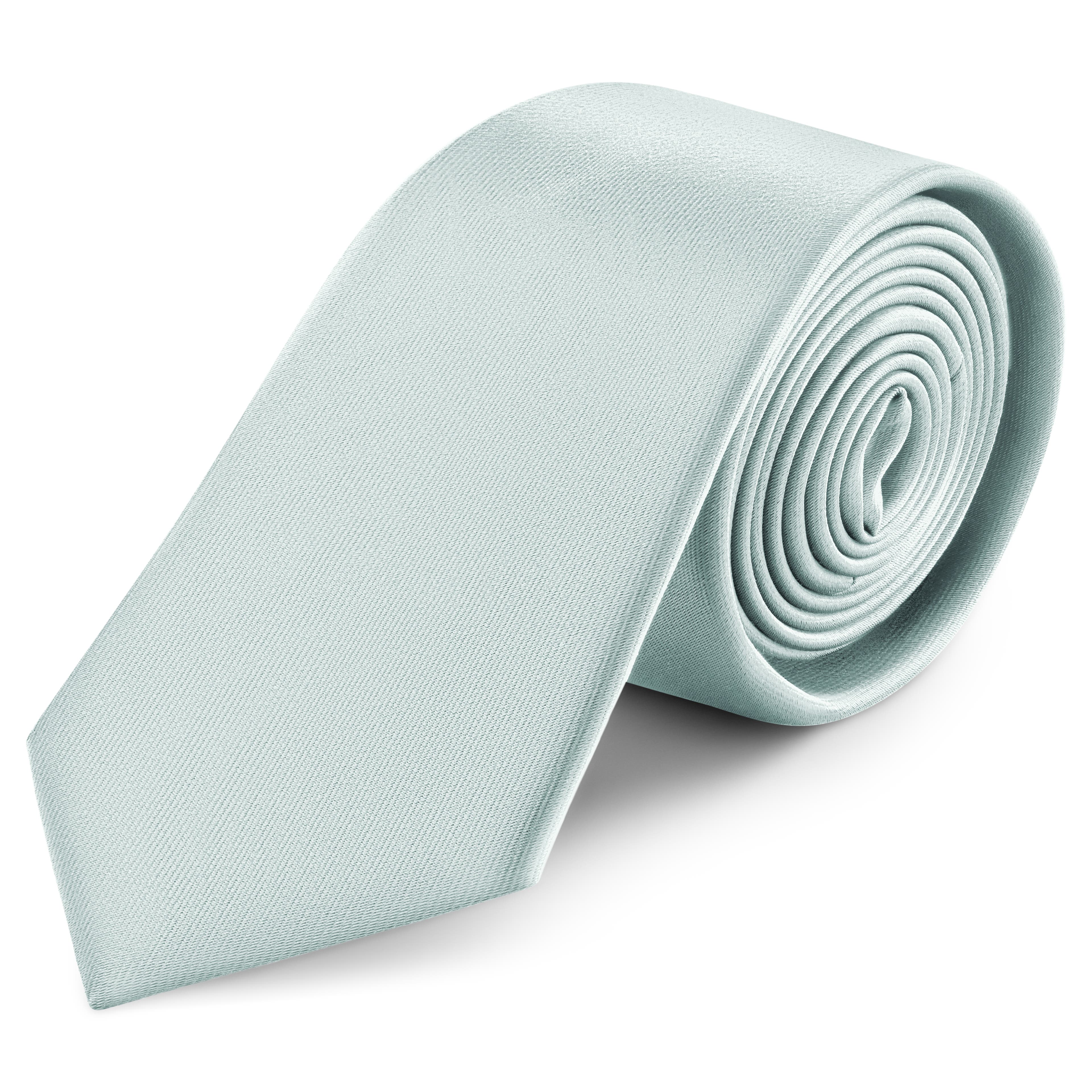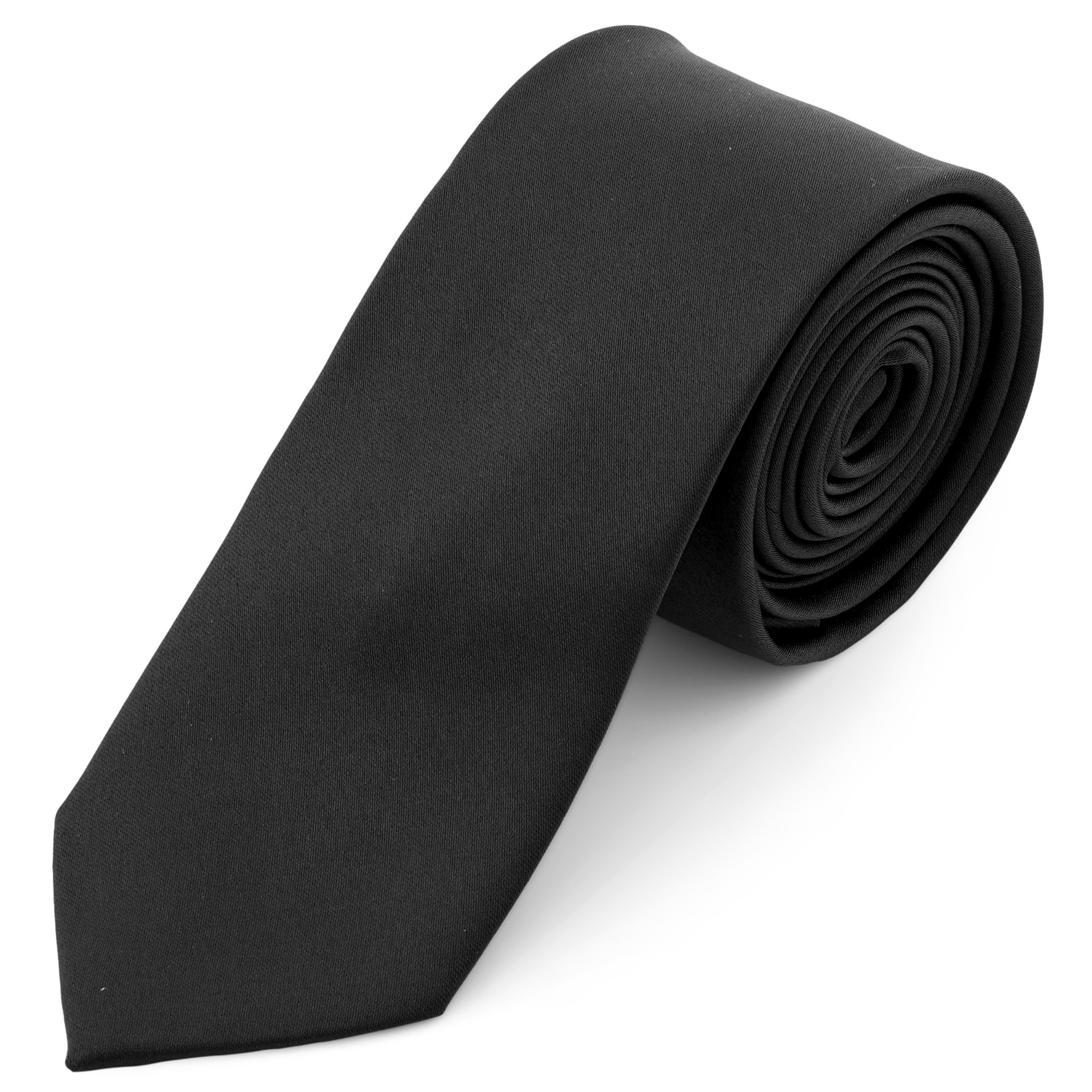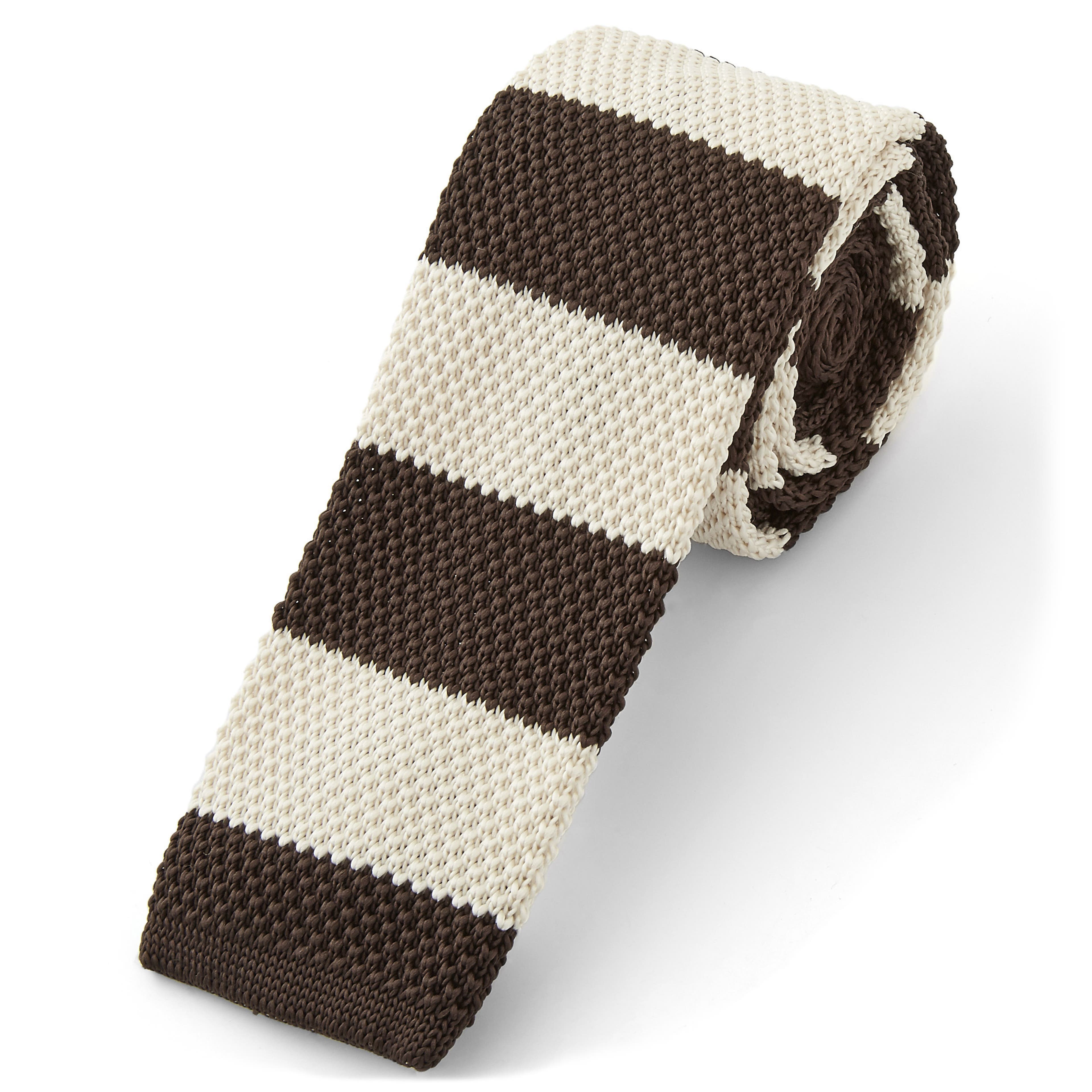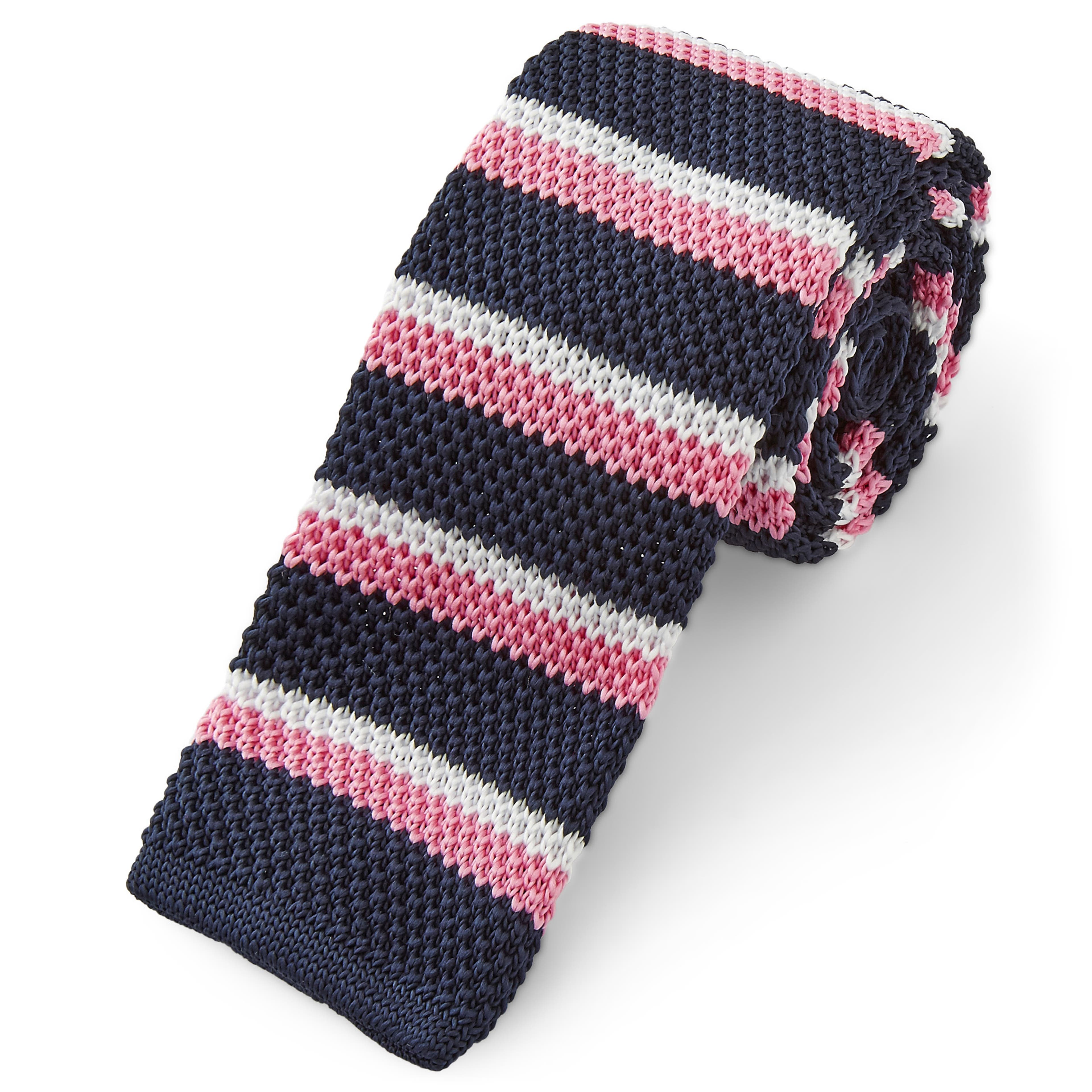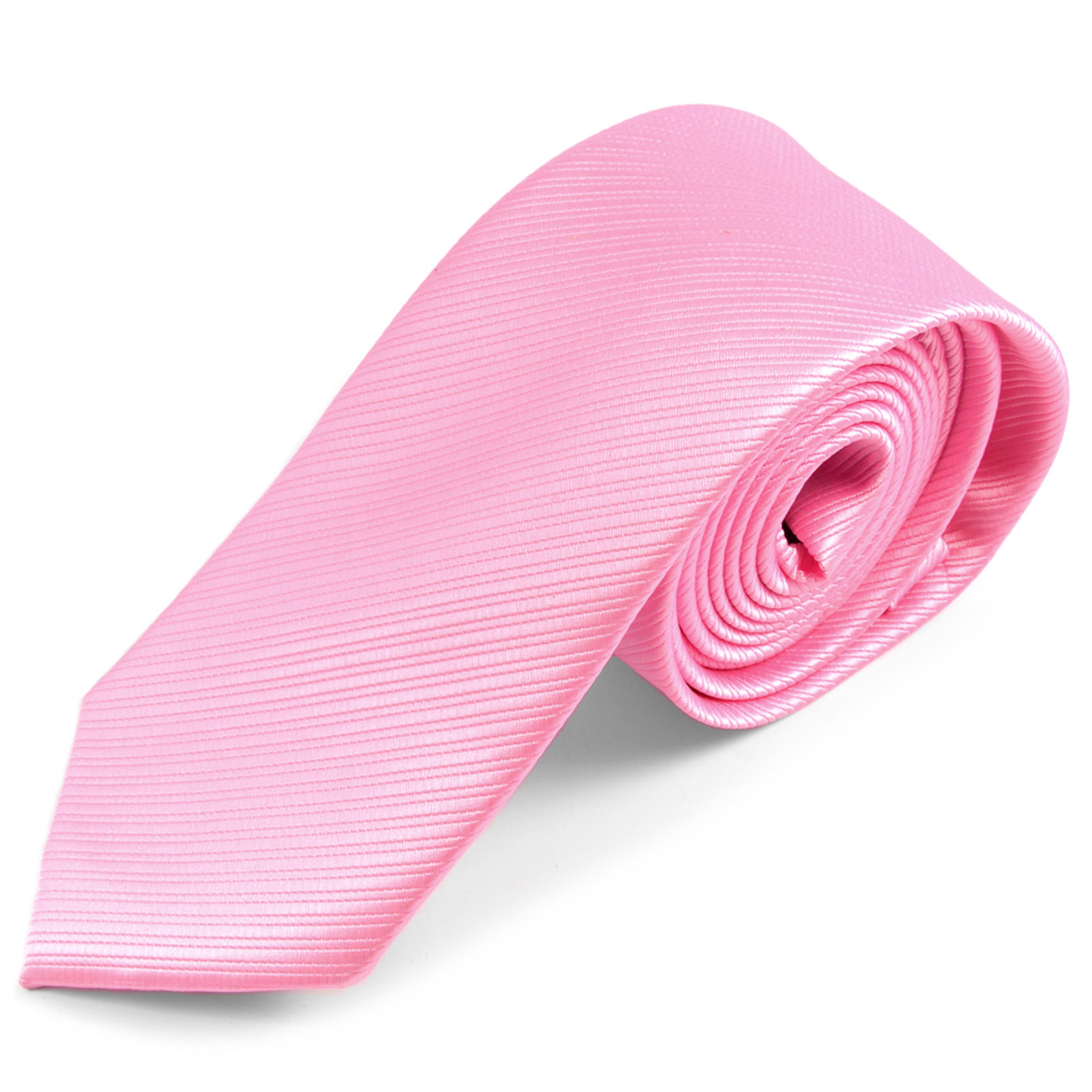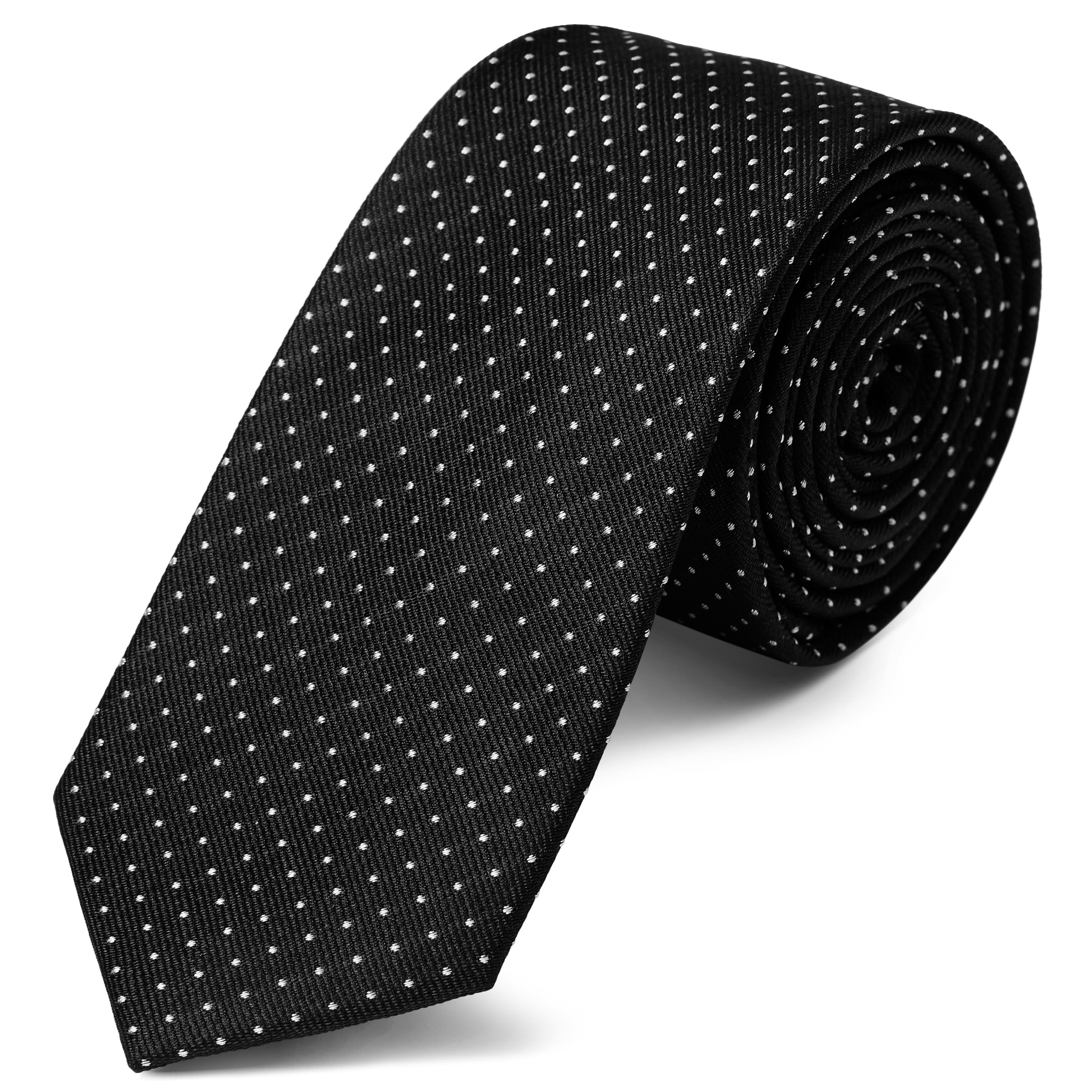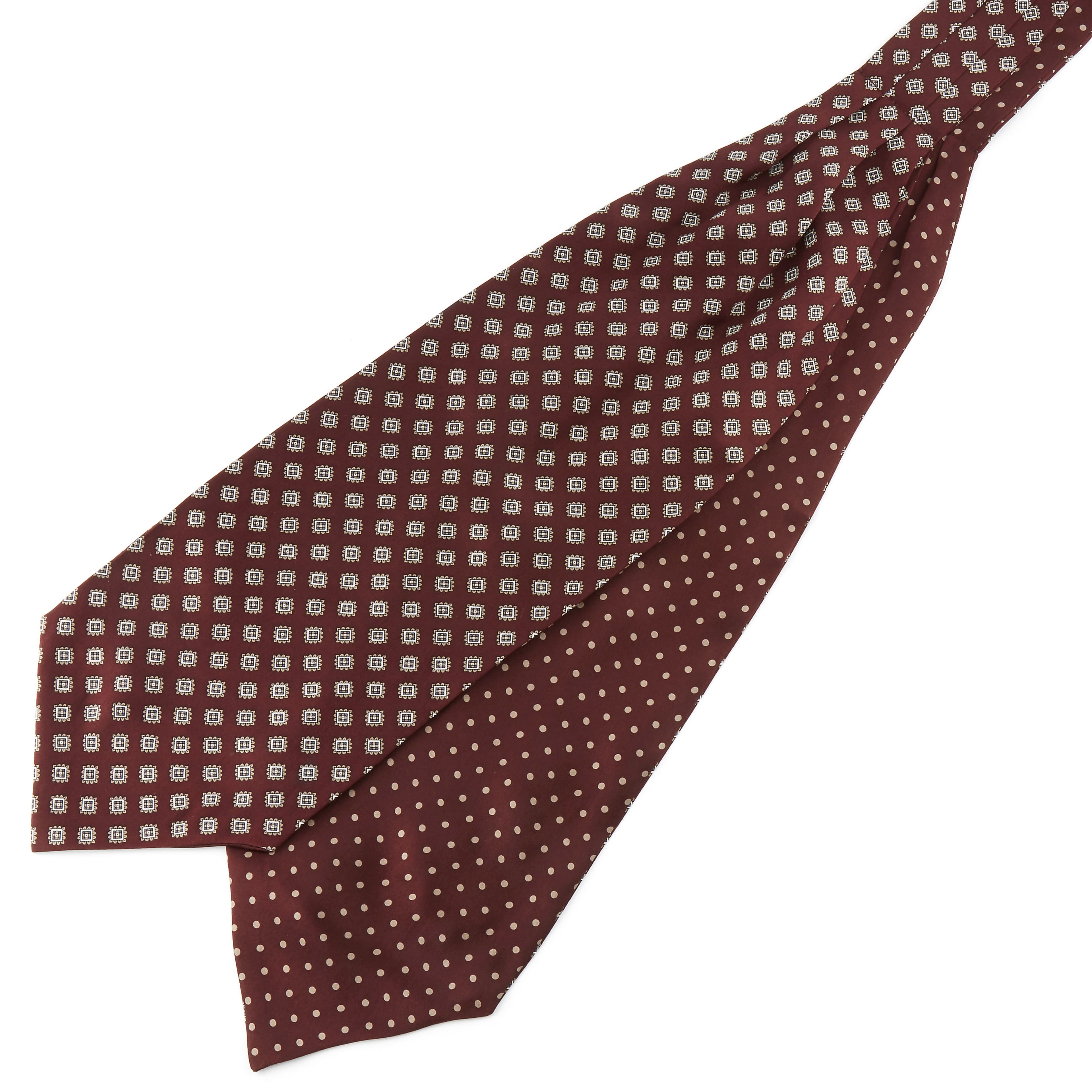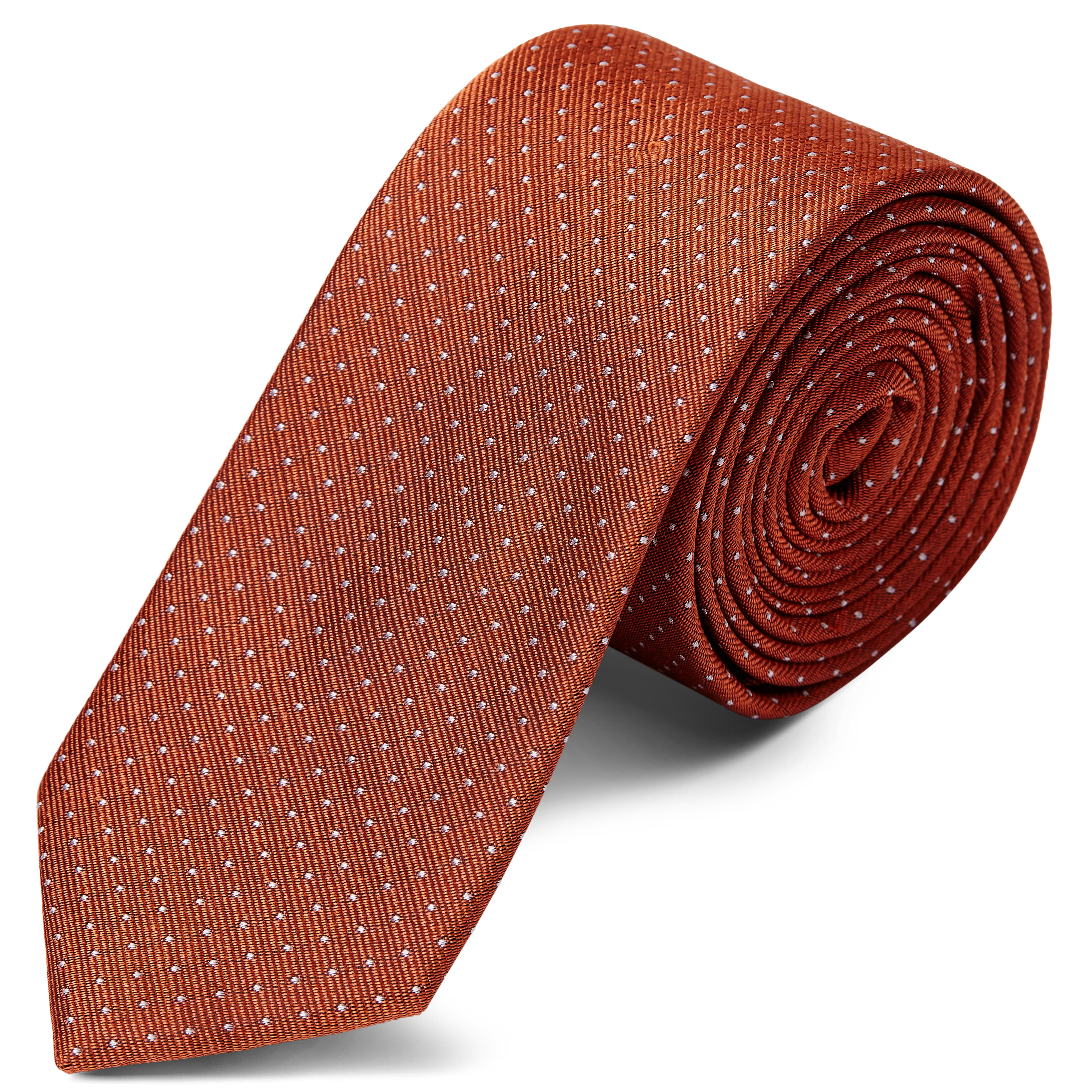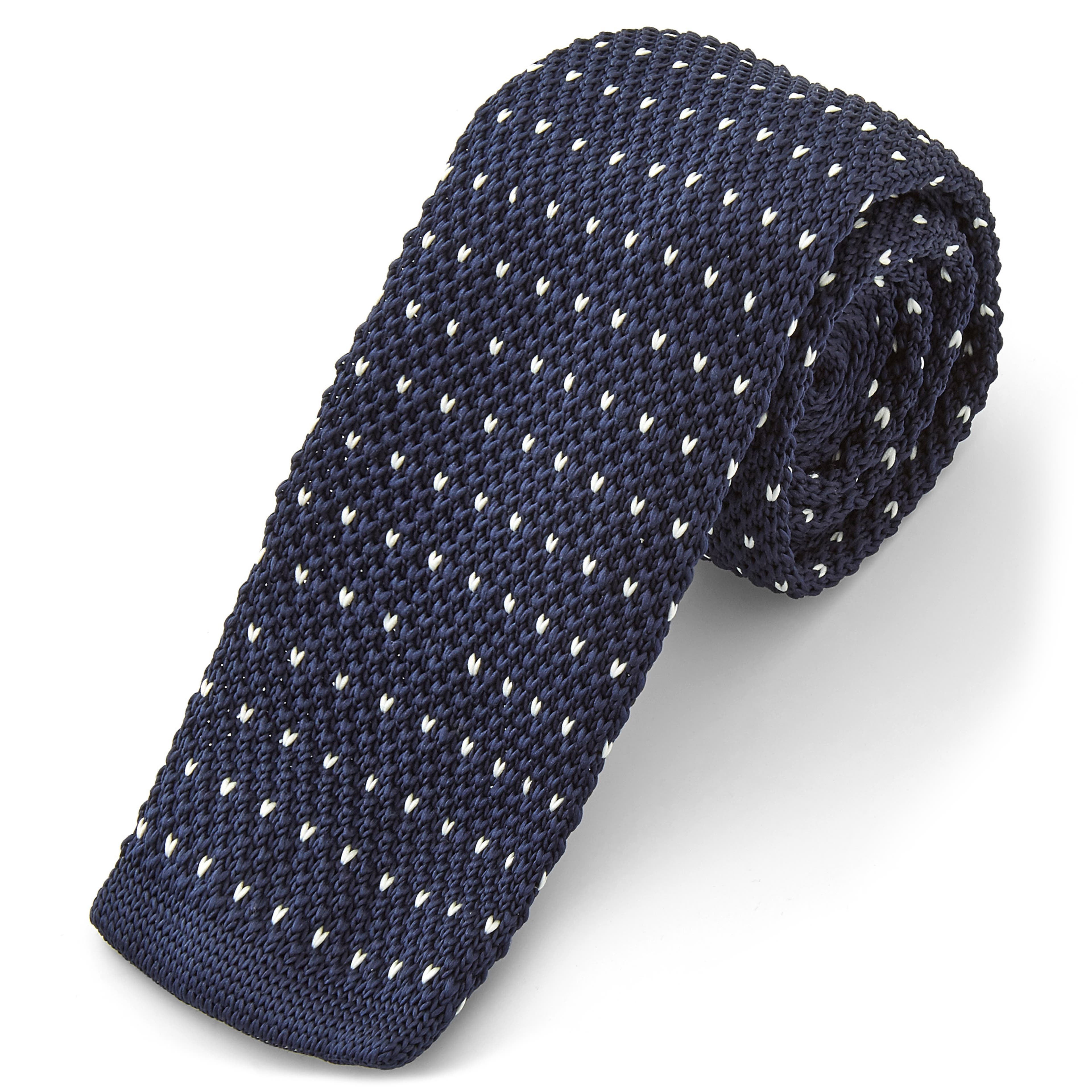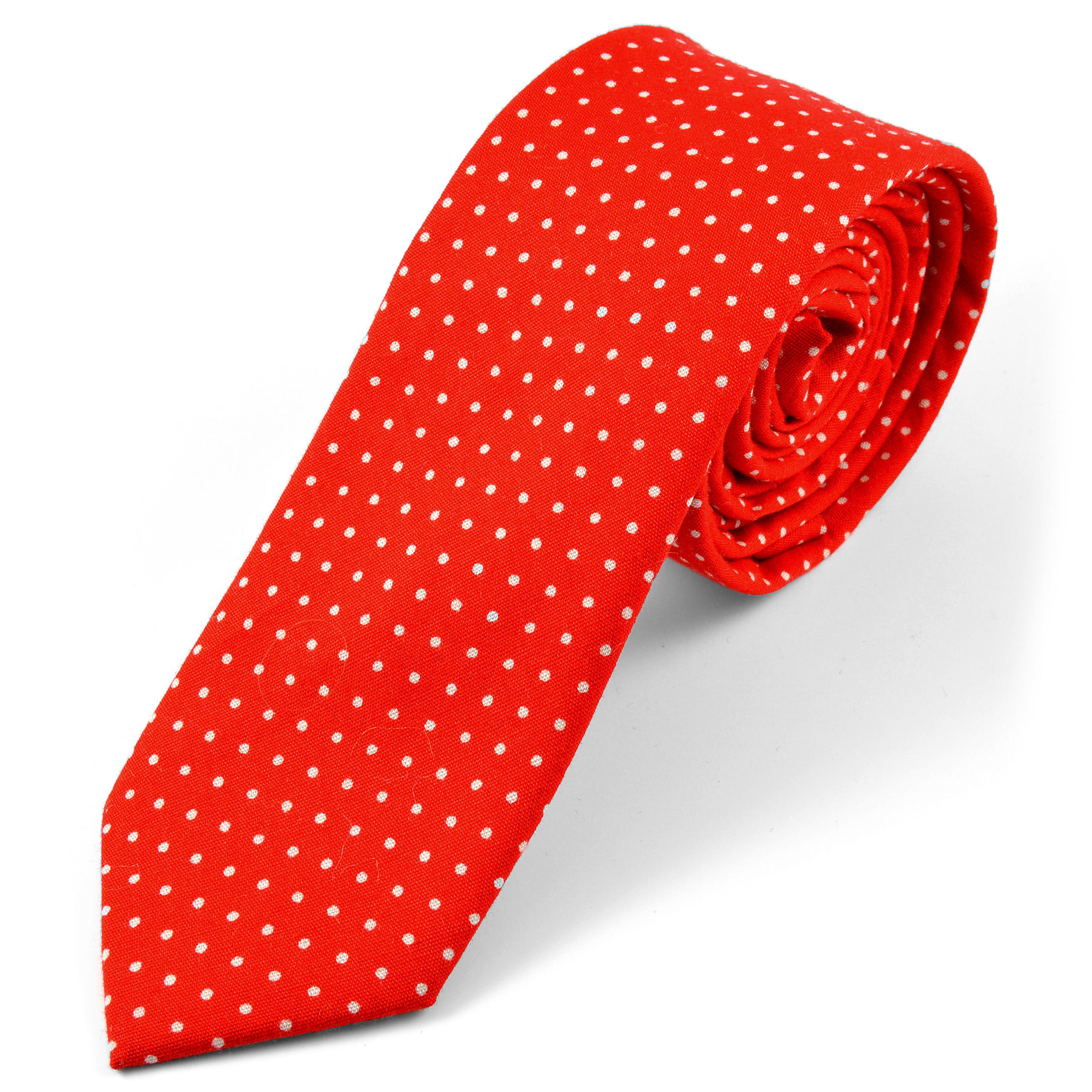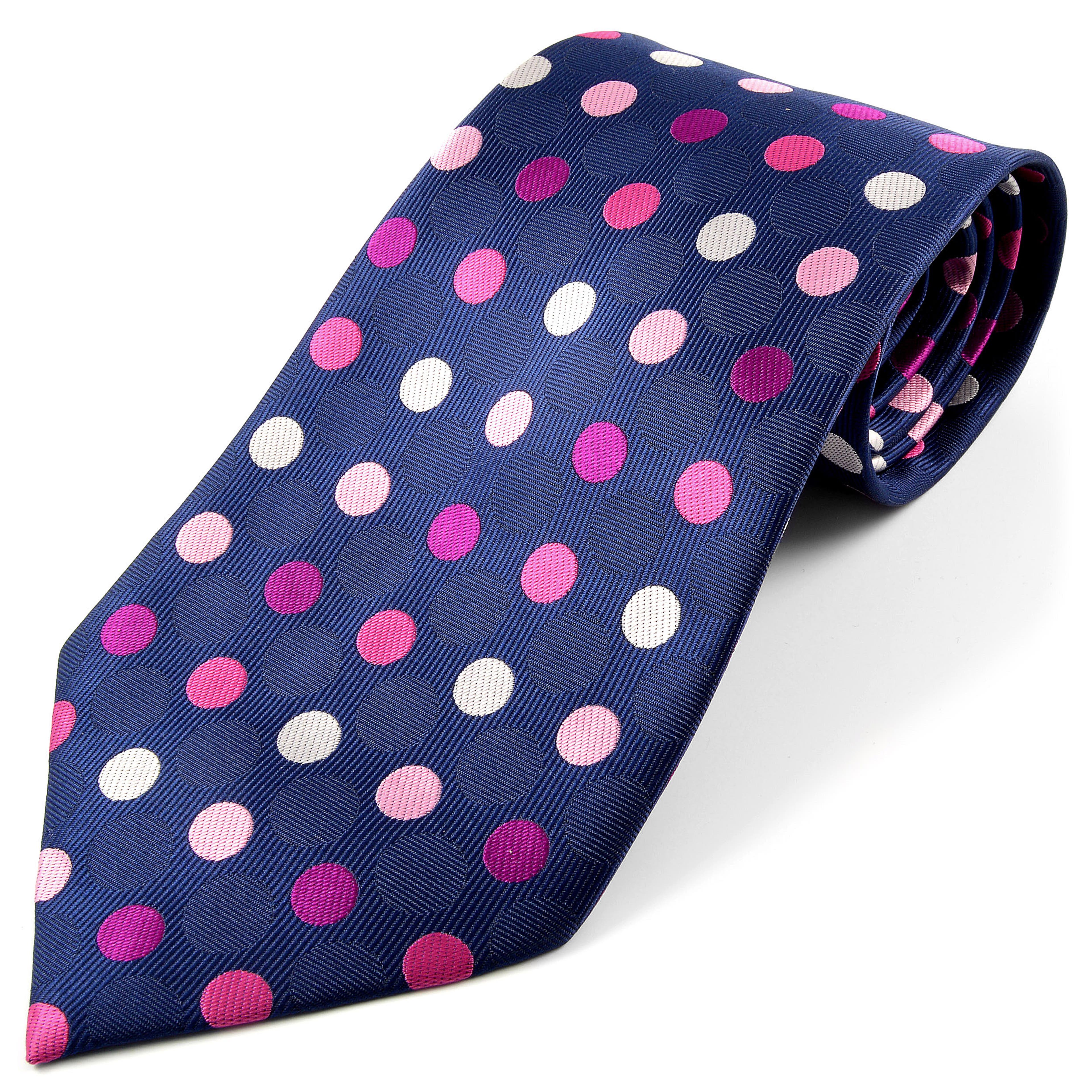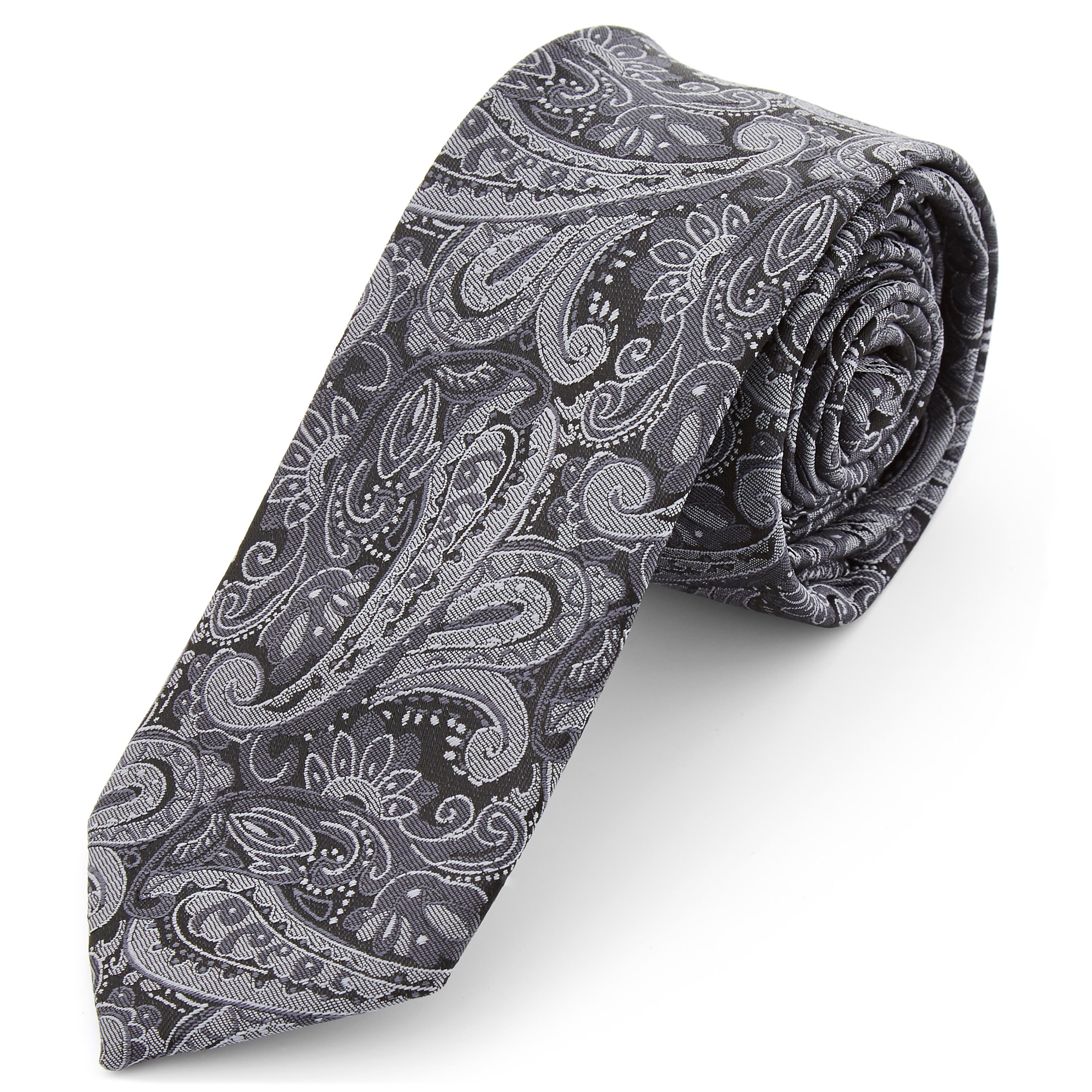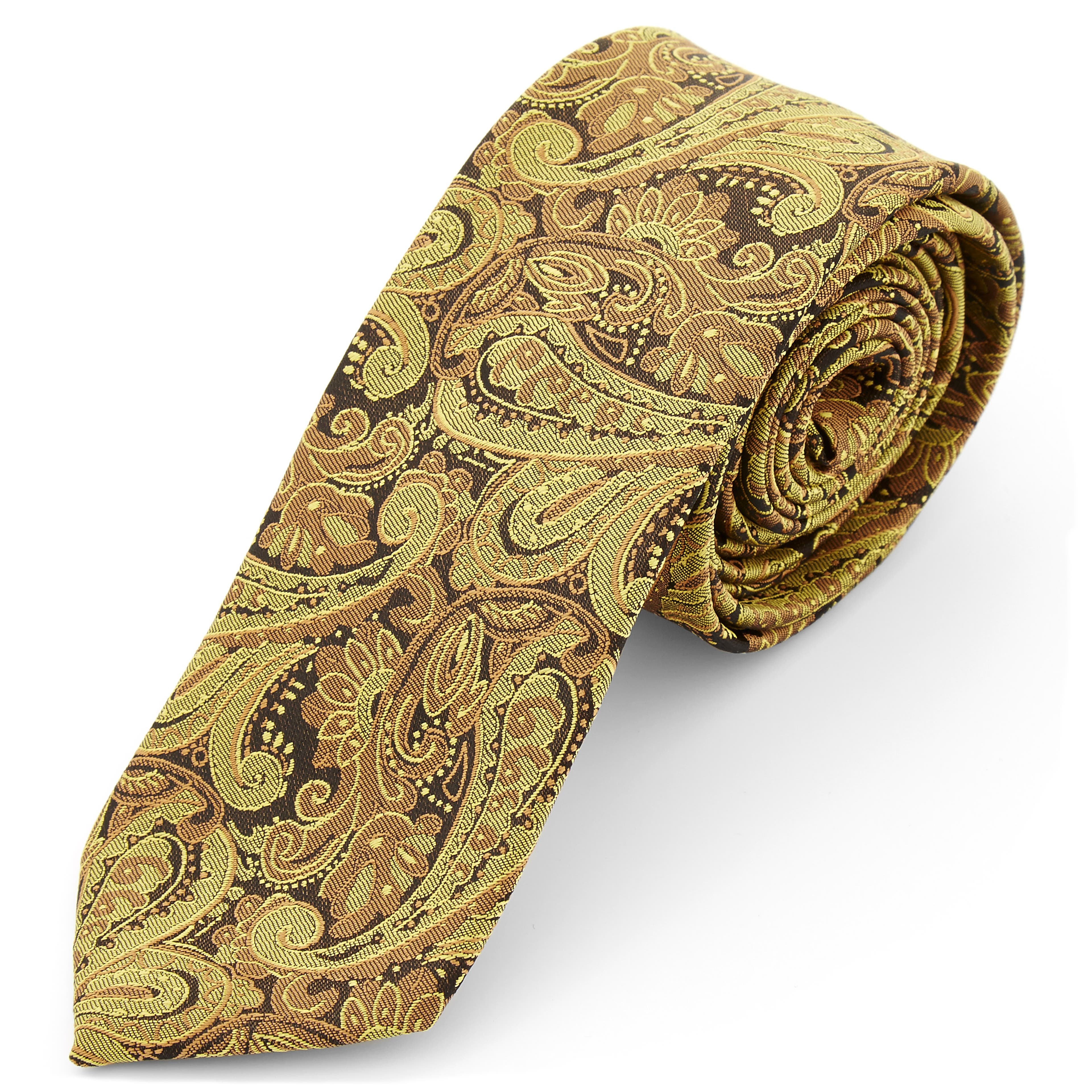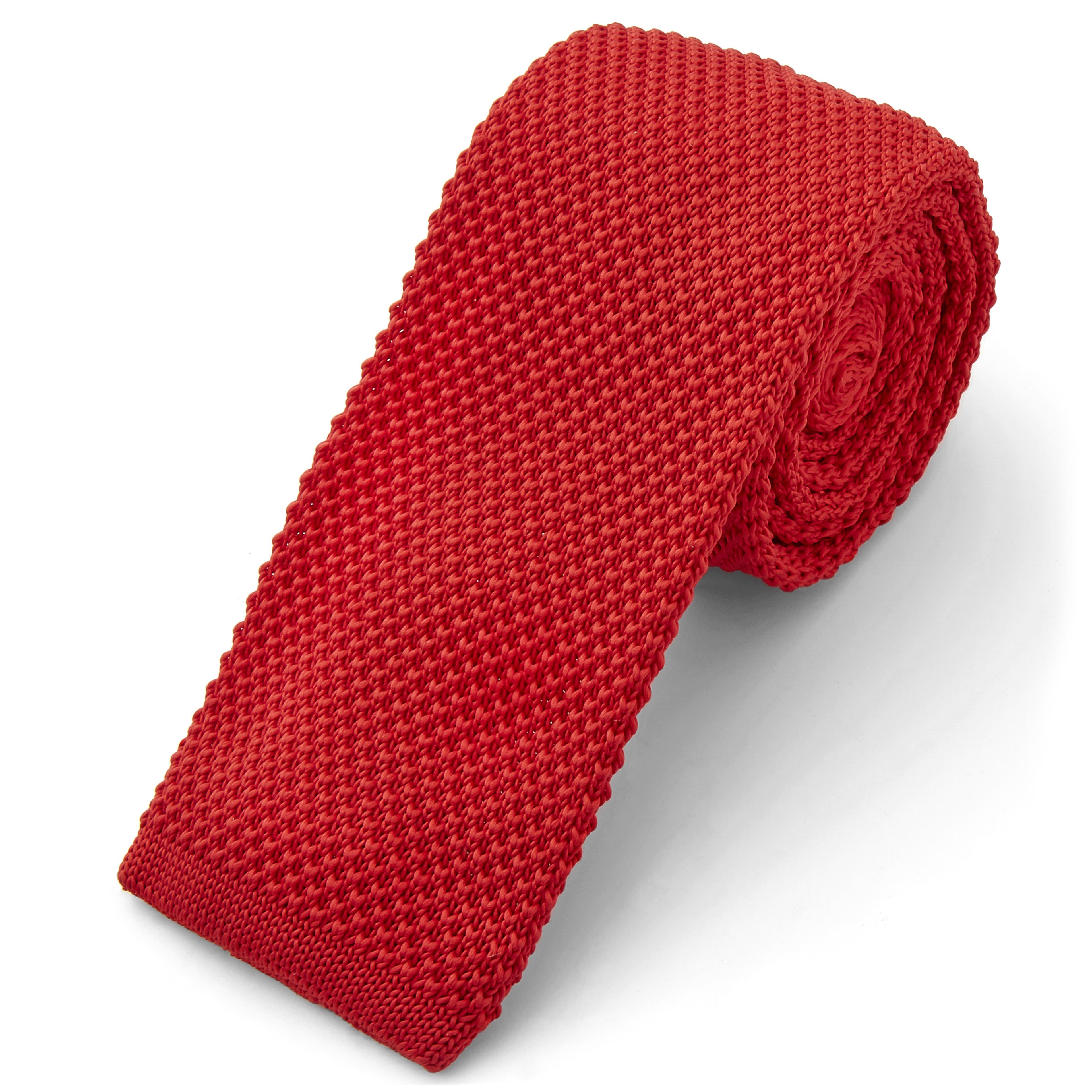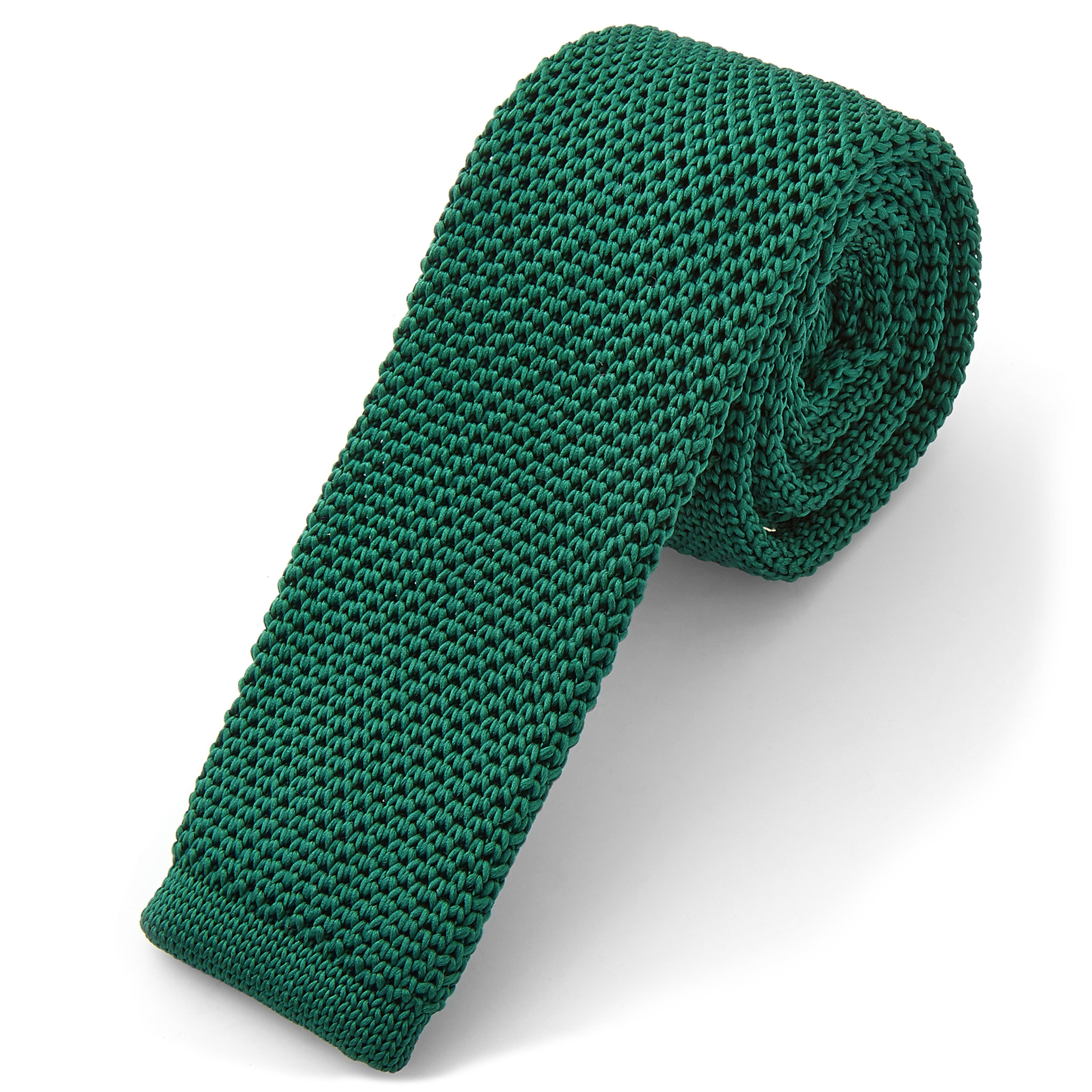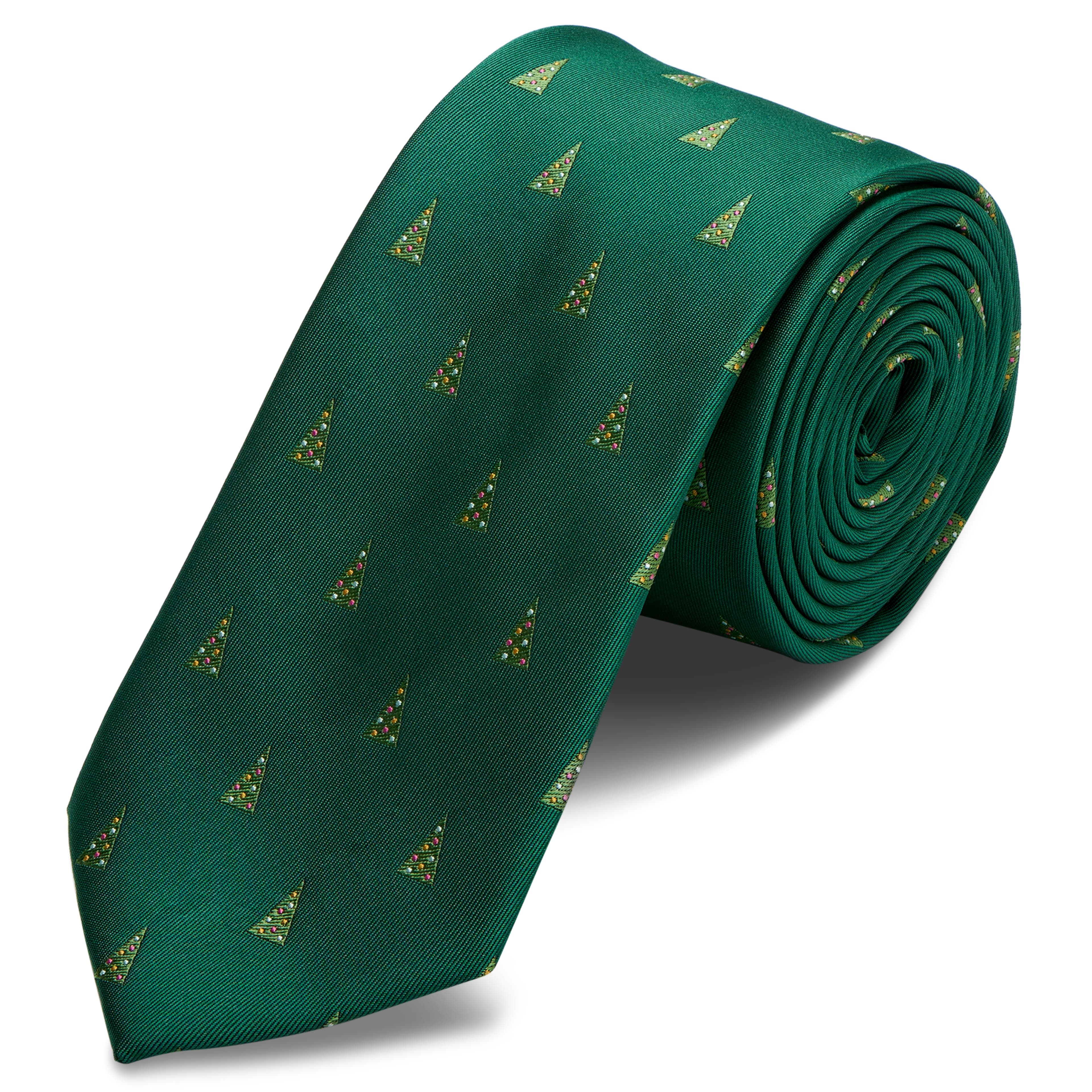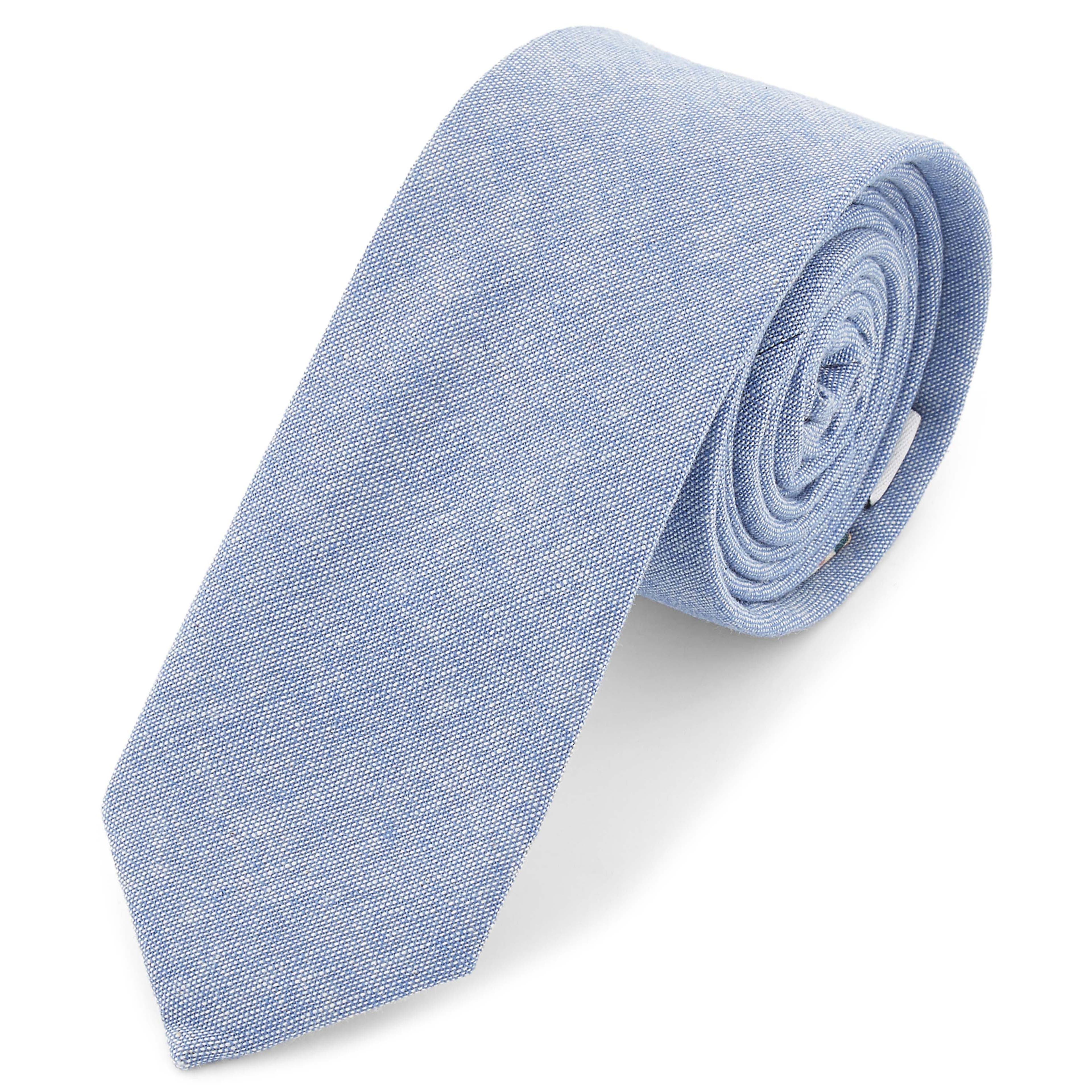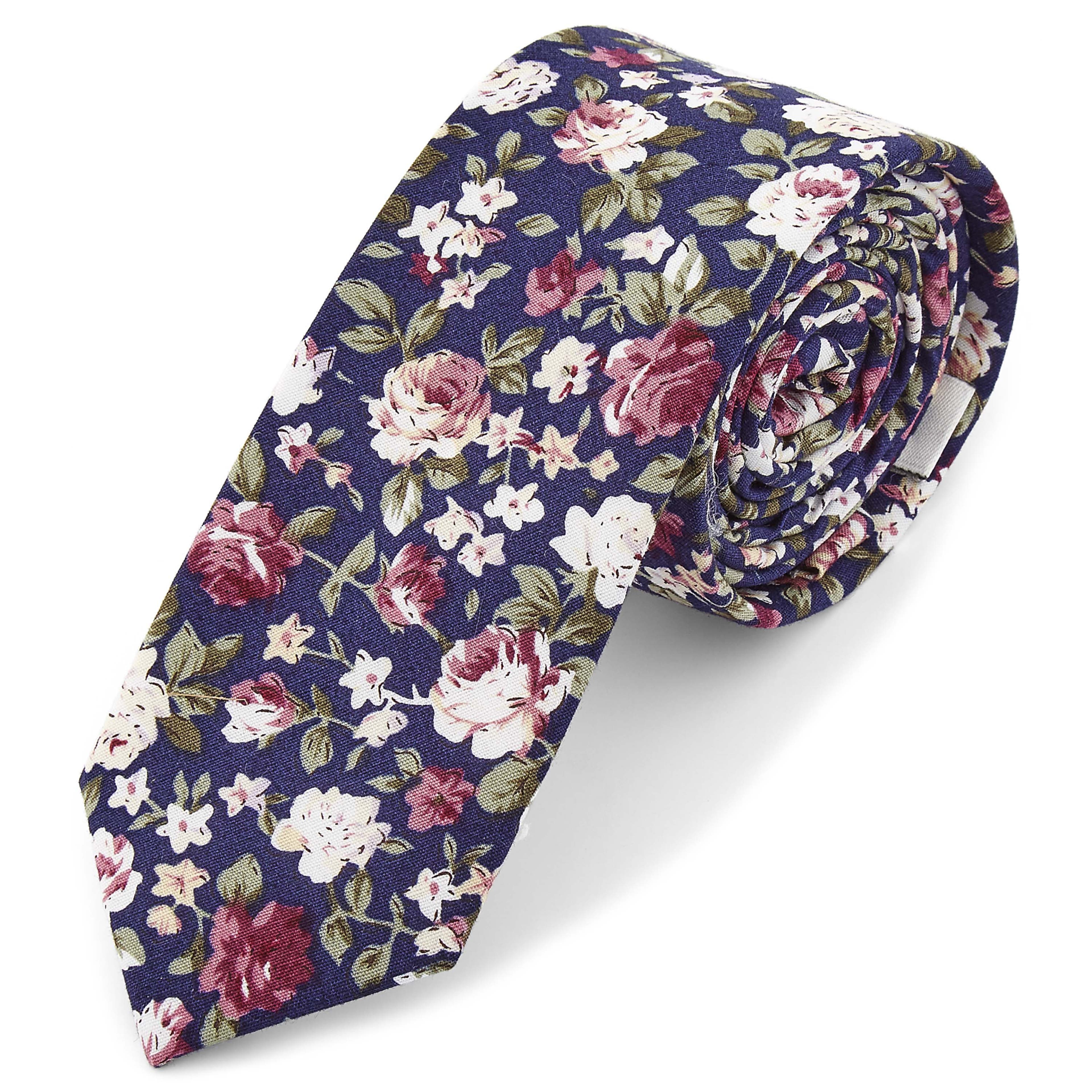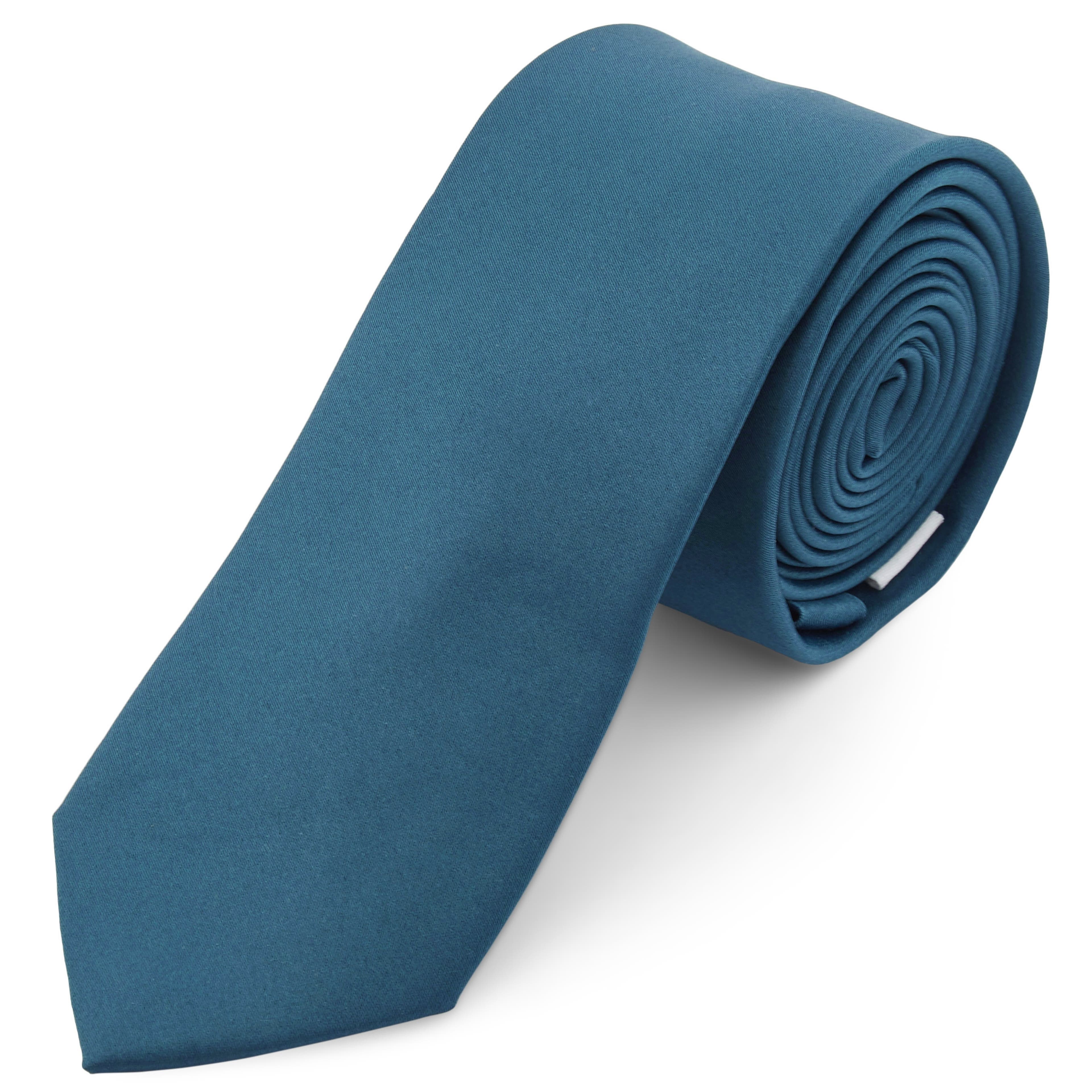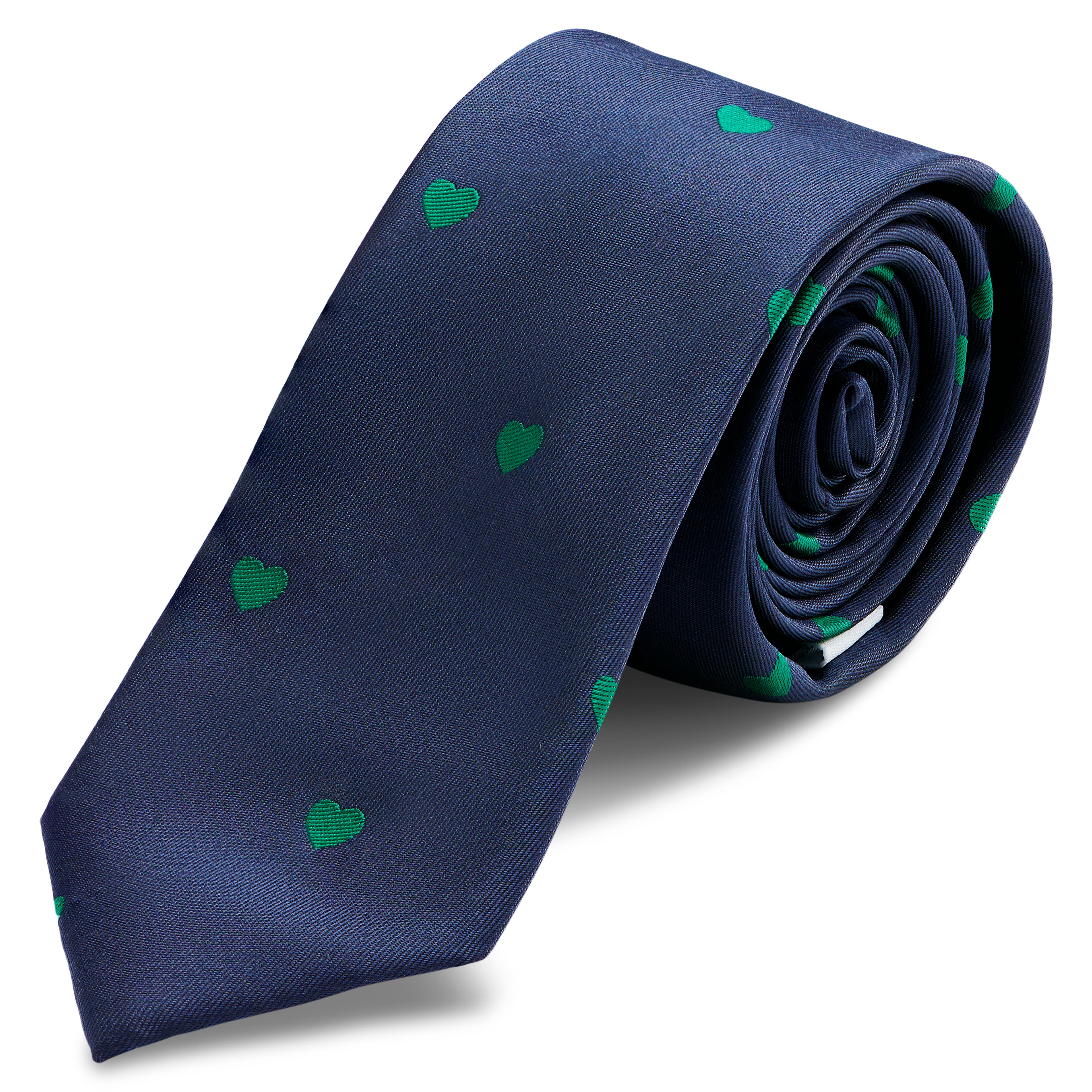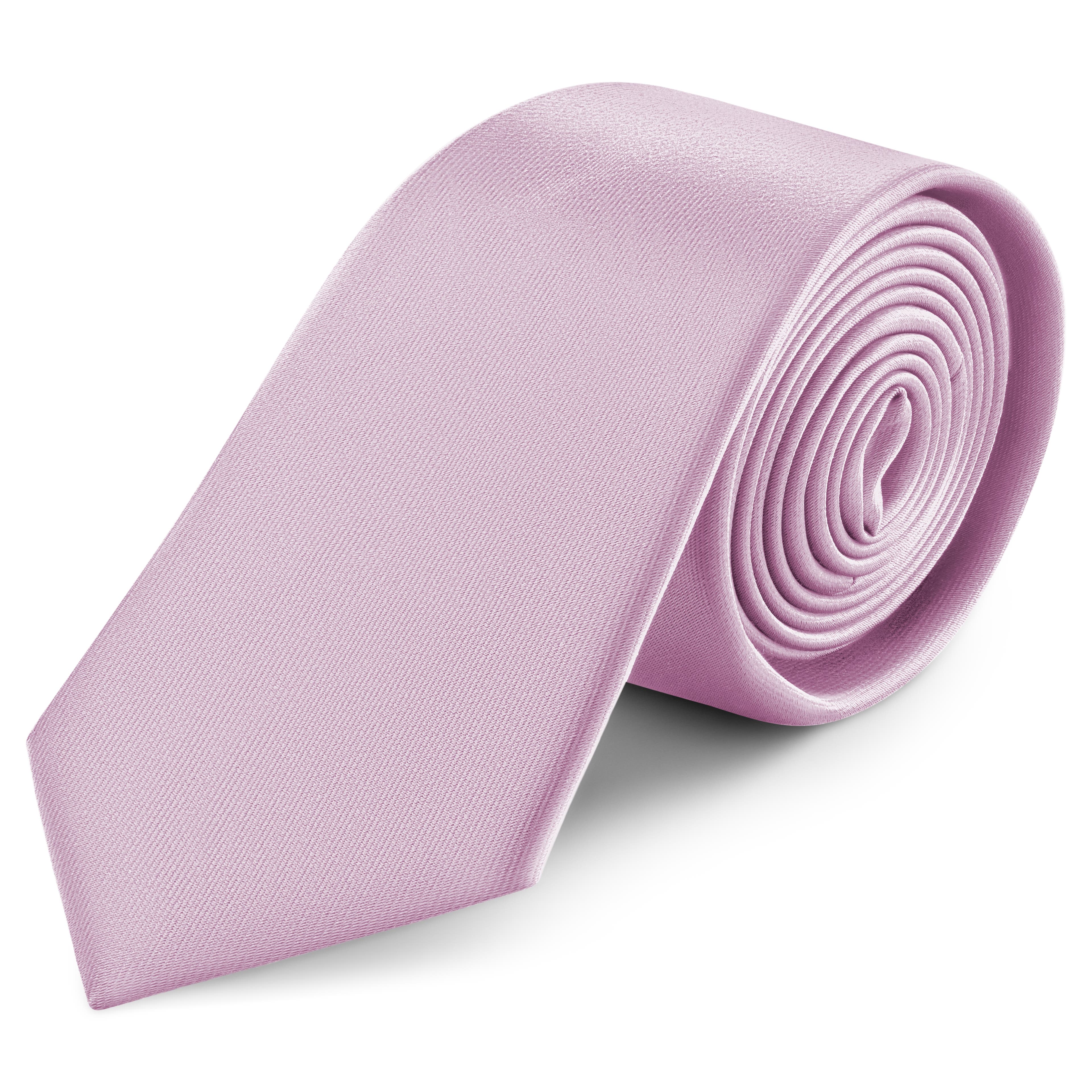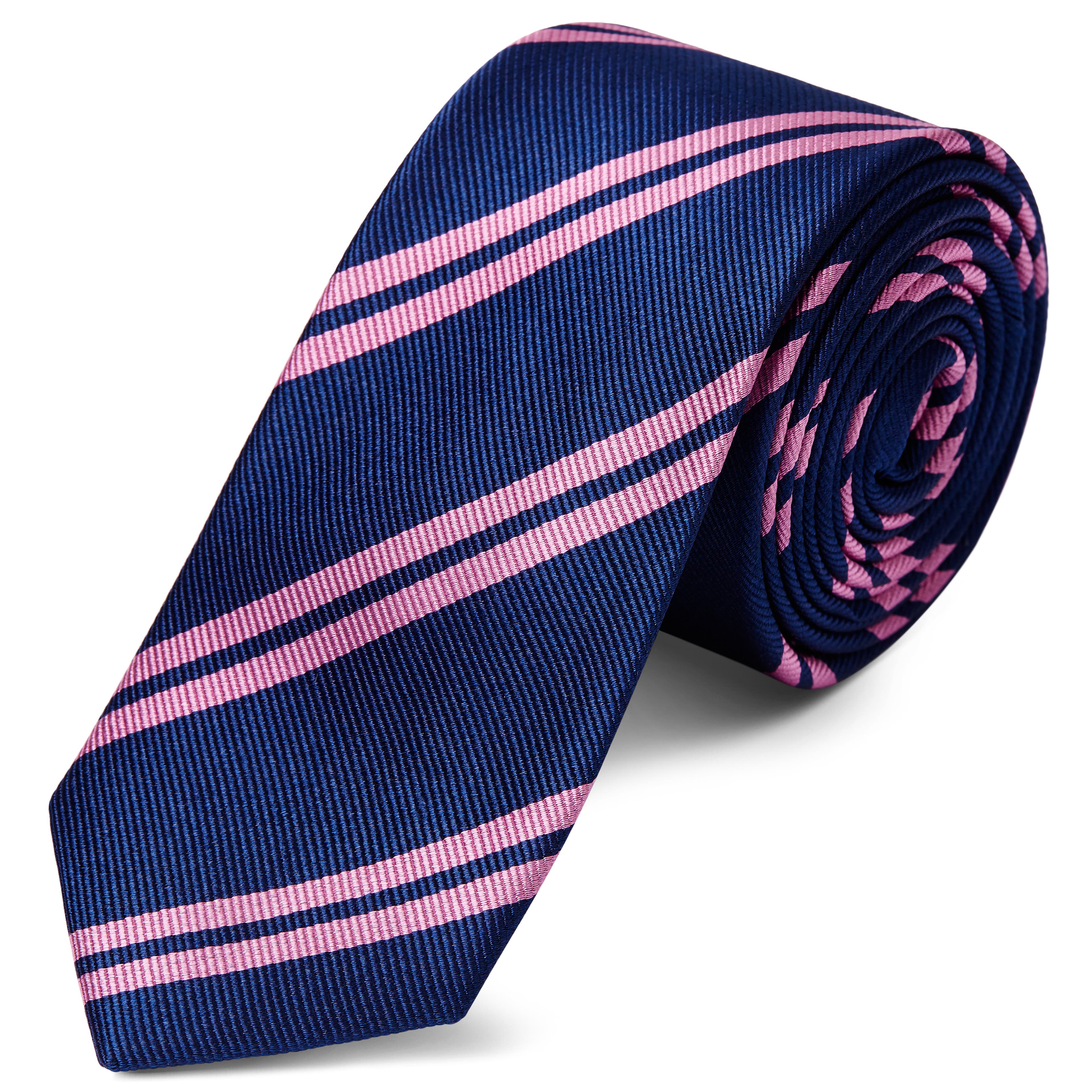The Necktie - Your Ultimate Guide
Learn everything there is to know about the necktie. From colour matching and fabric picking to learning how to tie classic knots.
Who doesn’t want to hear nice tie when entering a room? It’s better than a collective silence with crickets chirping in the background. Oscar Wilde once said, “A well-tied tie is the first serious step in life.” If that’s the case… it’s time to step up.
How to Wear a Tie
The fundamental principle of tying and wearing a tie is that it should look effortless. A type of elegant nonchalance that comes from practice and having the confidence to leave perfection at home.
Necktie Length
Wear the tip of your tie just above your belt buckle.

Necktie Width
Ties come in various widths from skinny to disco-style throwbacks with standard width ranging from 5-7 cm. One major factor affecting width is the suit’s lapels. The tie, at its widest point, should be roughly the same width as your suit lapel.
In general, wear a slimmer tie with slim lapels and a wider tie with wide lapels.
Also, consider your build. Are you broad shoulder? Try wider lapels and ties. If you’re described as slim and small in stature, opt for a slimmer men’s tie and lapel.

Necktie Anatomy
Understanding tie construction will make you an informed buyer and ensure that you purchase ties which are not only handsome but are built to last.

- Blade – The main body of the tie.
- Tipping – The material sewn on the reverse tip and tail. Self-tipping is when the same material as the tie is used. Decorative tipping involves a different material. If an inferior fabric was used, you may want to question the tie’s quality – It may have been a cost-cutting action.
- Bar Tack – A heavy stitch holding the 2 sides together and maintaining the shape.
- Label – This may have the name of the company or designer on it.
- Keeper Loop – Once tied, the small blade can be secured through the loop keeping it hidden. Double check that the small blade can actually pass through. When the keeper is made from the same high-quality material as the shell, it's a good sign that no shortcuts were taken and the tie is indeed quality.
- Neck – The middle of the tie.
- Shell – The outer fabric of the tie – also called the envelope. Your chance to choose between silk, wool, cotton or polyester.
- Seam – Where the pieces of material have been sewn together. A quality tie is made of an envelope cut on the true bias – 45 degrees from the finished edge of the fabric. The tie won't hang straight or survive everyday use if it wasn’t cut this way.
- Interlining – The inner material giving the tie shape and providing wrinkle resistance. A quality tie uses wool for its softness, durability and wrinkle-resistance. Some ties use cotton or synthetics which are inferior to wool.
- Tail – The thin end of a tie. It fits in the Keeper Loop once tied.
- Slip Stitch – A hidden stitch that holds the 2 ends together (works with the Bar Tack).
- Origin and Care Tag – This may include the country of origin and special instructions regarding cleaning.

Necktie Fabrics
The most common necktie fabrics are silk, wool, cotton and polyester. Each fabric has different qualities, but your main focus should be on the visual texture. Similar to pocket squares and bow ties, aim for contrast when choosing which tie fabric.
For example, a sleek, silk tie contrasts nicely with a thick wool suit or cotton pocket square. Similarly, a rough wool tie goes well with a silk pocket square or a very fine (high thread count) suit.
Silk Neckties
Silk ties are easy to store and have a soft hand feel. As luxurious as this natural material is, it’s equally as difficult to clean and wrinkles easily.
Wool Neckties

Wool neckties provide a different texture and depth to your outfit and are available in higher end wools such as cashmere. Known for making larger knots, this fabric is also difficult to wash and can shrink if not probably cared for.
Cotton Neckties
Neckties made of cotton are easy to iron, clean and store with the added bonus of being strong and durable. However, they can shrink in hot water and crease easily.
Polyester Neckties
Polyester ties are lightweight and easy to store. They can look inexpensive as many have a sheen in the light that looks artificial compared to silk.
Neckties Worth Knowing
Any necktie arsenal worth its firing power must include more than one type or style of tie. It’s perfectly fine to have a favourite, but don’t miss out on a fun polka dot necktie worn in the right context. Worried about getting one of these dirty? We’ve got you covered with our guide on how to store, clean and iron neckties.
Solid-Coloured Neckties
Solid-coloured neckties are ties in one solid colour. The most versatile are navy and burgundy, which look elegant with almost any outfit, and are a good place to start your tie collection. You can also experiment with lighter hues for warmer months and casual occasions.
Striped Ties
Striped neckties are some of the most popular ties for business wear, and are generally easy to match with a variety of outfits. A general principle is that the more spaced out and thinner the stripes, the more formal the tie.
Polka Dot Neckties
Not only do polka dot ties look simple, refined and elegant, but they’re unlikely to clash with other items you’re wearing… assuming your trousers aren’t in the same pattern. Other ‘dotted’ ties such as small squares, diamonds or other shapes could fall in this category.
Paisley Ties
Similar to polka dot ties, paisley ties offer an interesting option compared to a solid. Paisley is a middle-eastern floral pattern that has been a mainstay throughout history.
Knitted Ties
Knitted ties are ties that are knitted. Didn’t see that coming, eh? You can tell a knitted tie by its texture, which is rougher than the usual woven ties, and their flat end versus a taper.
Knitted ties are quite casual and are well-suited for everyday office wear.
Christmas & Novelty Ties
Usually fun and hopefully funny, novelty ties are best left for family gatherings, easy Sunday barbecues and as options to the ugly Christmas sweater. For the sake of your career, we don’t recommend this type of tie for your first interview for a new job. Unless it’s to be Santa’s little helper… in that case, go crazy!
Grenadine Neckties
Shaped like a regular tie with a tapered end and standard width, Grenadine ties are much better suited to formal wear than other knitted ties. Besides the width and end, Grenadine ties differ in their weave, which is far more complex and tighter. This also makes them quite expensive.
Macclesfield Ties
Macclesfield ties are named after a town in Cheshire, England, which became famous from the 17th century for its silk weaving and the particular type of pattern they produced. This type of pattern is the same as Foulard or wallpaper ties. The Foulard tie is a simple geometric repeating pattern that usually entails flowers, geometric shapes – squares, diamonds, dots – or individual paisley shapes.
Macclesfield, today, is a generic name describing ties with small geometric woven patterns. These patterns should be of woven silk – small printed motifs are called all-over.
3 Ways to Tie a Tie
Learning how to tie is the most important step in wearing one. Now is the time for the serious step Mr Wilde was talking about.
We suggest starting with a shirt that has been washed and worn before to avoid anything too stiff. You may also find it easier to fasten your top button after the knot is finished.
The Four-In-Hand Knot
The Four-In-Hand is often referred to as a simple knot as it’s perhaps the easiest to learn… and it looks great with a dimple! It’s best suited for men with smaller necks or ties with a heavier fabric.
Click here to find this video in Danish, French, Dutch, Italian or Spanish.

How to Tie a Four-In-Hand Knot
- Start with the wide end of your necktie on the right (mirror image). It should extend about 20 cm below the narrow end.
- Wrap the wide end once around the narrow end.
- Pull the wide end up and through the loop around your neck.
- Hold the front of the knot loosely and bring the wide end down through the front loop.
- Tighten and slide the knot up.
Half Windsor
The Half Windsor is also asymmetrical, but wider and more structured than the Four-In-Hand with a neat, triangular finish. A go-to classic striking the perfect balance of formality with everyday wear. Its medium size goes with most collar types. Best suited for medium-weight ties.
Click here to find this video in German, Danish, French, Dutch, Italian or Spanish.

How to Tie a Half Windsor Knot
- Start with the wide end of the tie on the right (mirror image). The wide end should be longer than the narrow.
- Cross the wide end horizontally in front of the narrow end.
- Take the wide end around and behind the narrow end.
- Carry the wide end over and through the opening near your neck.
- Wrap the wide end across the front of the thin end
- Pull the wide end under and through the neck opening. Pull the wide end of the knot through the loop formed in the front.
- Tighten the knot by pulling down on the wide end.
Full Windsor
The Full Windsor is a large knot often used by the armed forces for its authority and formality. The Windsor gives a symmetrical, triangular finish and is best suited to thick necks and ties made from lightweight fabrics.

How to Tie a Full Windsor Knot
- Start with the wide end on your right (mirror image) hanging 12 cm below your belt.
- Cross the wide end horizontally in front to make an X below your chin.
- Bring the wide end up and beneath the loop around your neck.
- Carry it through the loop and pull the wide end all the way down.
- Bring the wide end around behind the knot and pass it to the other side.
- Loop the wide end over the top of the loop around your collar and bring it back down. You now have 2 loops on either side of the thin end.
- Bring the wide end across the front of the knot to form a band. Use a finger to hold it in place.
- Bring the wide end underneath the loop towards your chin.
- Pull the wide end through the front band.
- Pull the wide end all the way down and smooth out any creases in the knot.
How to Tie a Necktie with a Dimple
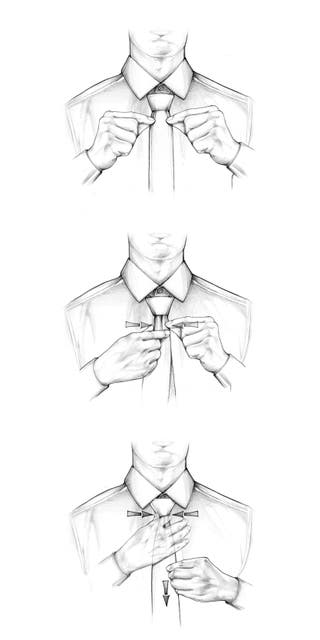
The infamous dimple is the slight dent just below your knot. Whether your tie is made of wool, silk, cashmere or it’s your favourite knitted one, a tie dimple is possible.
- As you finish tying your tie, press your thumb and index finger together just beneath the knot to form a crease.
- Pull your tie tight as you hold the dimple in place.
- Adjust the dimple to accentuate the fold.
Tie Accessories
The main necktie accessories are tie clips, chains, tie straps, bars and pins. The overall purpose of these items is to hold your tie in place… but they do much more.
Tie straps keep your tie from going wild in the wind. Afraid it will fall over in your soup? Try a tie clip or chain. Knot looking flat? Use a collar pin to push it slightly forward for an extra pop.
How to Match a Necktie to Your Suit
The most important piece of advice is to match your tie to your suit – not your suit to your tie. In other words, buy your suit and shirt first… then shop for a tie that matches.
- A modern cut suit works well with a skinnier tie.
- Avoid extremely wide or super narrow ties. Standard width is 5 to 7 cm at its widest. Going too far in either direction can leave you looking dated.
- Your tie should be darker than your shirt and in a solid colour.
- White shirts, including cream and off-white, can be worn with just about everything. Black, grey and navy suits are similar – they match almost everything.
- Wear a bold colour to punch up a sombre look.
- If you like patterned shirts and blazers, make sure the tie complements the core colours of the shirt. The core is the main colour.
The above is a very general, easy-to-follow set of rules. We’re big fans of patterns around here. Learning how to work with them isn’t as tough as you may think, and it’s completely worth it. All it takes is a little confidence.
What Colour Tie Goes With a White Shirt?
Wear any colour tie with a white shirt. If you're wearing a navy blue suit, choose a necktie with blues and a pop of red.

What Tie Matches a Blue Shirt?
Light blue shirts work well with ties in the same colour family (blue) as well as dark green, shades of yellow, burgundy or pink. With a grey suit, match a light blue shirt and a floral printed tie for a relaxed, yet elegant, look.

What Kind of Tie Looks Good with a Blue Stripe or Checkered Patterned Shirt?
Wear a tie darker in colour than the shirt and with a pattern larger than the stripes or checks on the shirt. To match your suit, choose a colour that complements your suit color – like a navy tie with a grey suit.

What Colour Tie Goes with a Pink Stripe or Checkered Pattern Shirt?
Wear a tie darker in colour than the shirt and with a larger pattern than the stripes or checks on the shirt. A winning suit and tie combo is a grey suit and tie with bold reds and pinks that match the stripes in your shirt.

How to Match a Tie with a Dress Shirt & Suit
The key to adding a suit jacket with your shirt and tie is to make sure that 1 of the 3 pieces – suit, shirt or tie – is a solid.

Top Tip for Matching Your Tie and Suit
- Your tie should be the last thing you purchase. Select your suit and shirt first.
It’s always easier to find a tie that matches your shirt… instead of finding a shirt to match your tie.
Want more necktie knowledge?
Check out our complete guide to cleaning, storing and ironing your tie here.
Your Party Chatter Version of the Necktie’s History
The earliest neckwear was worn by the famous Terracotta Army in Xi’an, China, who were buried to protect their emperor in the afterlife about 210 BCE. Throughout history, neckwear has been found all around the world as a sign of wealth and status. However, the modern necktie is directly descended from... 17th-century Croatian mercenaries (bet you weren’t expecting that).
These hired killers were elite troops working for the French during the Thirty Years’ War. King Louis 14th took a fancy to his new war heroes and started copying them – except he changed their red scarves into a massive white lace cravat. In fact, the French word for tie is ‘cravate’ and is derived from the word for Croatian –‘croate’. In classic sycophantic style, the Parisian elite then imitated the king, and the cravat spread throughout French society.
In 1660, Charles II returned to England after being exiled in Paris and brought this new fashion back with him. Time went on and the tie’s design grew simpler during the Industrial Age as the need for a tie that stayed tied increased.
Over the years the tie has taken many forms, going from wild colours in the 70s to skinny ties worn by hipsters everywhere. No matter the time period, the necktie represents an individual's style and will always make an impression.
You Asked – We Answered
Why do men wear ties?
Modern ties are mostly decorative and are used to show personality and/or are a requirement for work.
Do ties come in different lengths?
Most ties are the same standard length around 145 cm. For the tall guy out there, long ties, around 157 cm, are available from specialty tie shops.
What is the easiest way to tie a tie?
We feel the easiest knot is the Four-In-Hand. Although anything can become easier with practice.
Which ties are suitable for the office?
In general, skinny ties are casual and not suitable. The darker the tie, the more formal it is. When in doubt, go with a solid-coloured burgundy or navy tie.
What colour shirt and tie should I wear with a navy suit?
A navy suit is one of the most versatile you can own. The classic shirt choice would be white. For the sake of simplicity, we’re going to suggest a tie in the red family. Red ties match a blue suit better than any other suit colour.
If you’re looking for a more discreet option, look for salmon, coral, pink or burgundy. These are still in the red family but aren’t as bold as a solid red.
What is the proper tie clip placement?
Tie bar placement should always be between the third and fourth button from the top of your shirt. Read our ultimate guide on the tie clip to learn how to properly wear a tie clip.
Why are neckties almost always self-tied but bow ties usually pre-tied?
Most men know how to tie a necktie, and it’s quick and easy to learn. Bow ties are a bit more complex.
What criteria do I use when selecting the type of knot for my necktie?
You want a knot befitting your situation. Wider knots, like the Full Windsor, are more authoritative and formal.
Thinner knots, like the Four-In-Hand, are more casual and laid back.
Which knot you choose will also depend on the material from which your tie is made. Thicker materials are better suited for thinner knots… so as not to look too big. The same is true for thinner materials.
Can you put a silk tie in the washing machine?
Definitely not! Doing so would ruin it. Read more on how to clean, store and iron your neckties and get the most from your neckwear.
Can I wear a necktie with a tuxedo?
You can wear a necktie with a tuxedo, and it’s becoming more and more common as a way of ‘dressing down’ formal wear.
Personally, we think that if you’re going to wear a tux, go all the way and opt for a bow tie. But if you do go for a necktie, at least make sure it’s black silk.
Which ties should I wear in winter?
Wool ties are generally better suited for winter with their thicker, rougher texture. In terms of colours, go for darker shades of blue, grey and brown. And don’t forget a Christmas tie.
What ties should I wear in summer?
As opposed to thick, wool ties in winter colours, opt for linen or cotton ties in light and bright colours for the summer heat.
Do you have a matching pocket square for this tie?
We actually receive this question on a daily basis. And the answer is yes, we do!
To find a pocket square that matches your coloured tie, use our Interactive Colour Wheel and the instructions in 7 Essential Rules for Matching Men’s Accessories. You’ll find the perfect match in no time!






